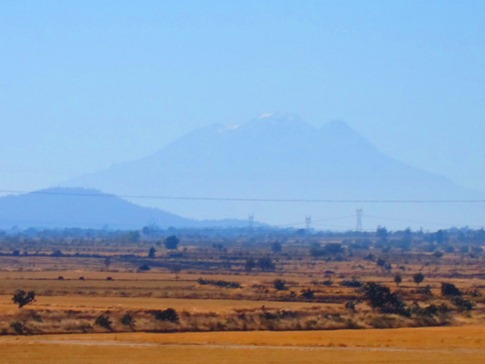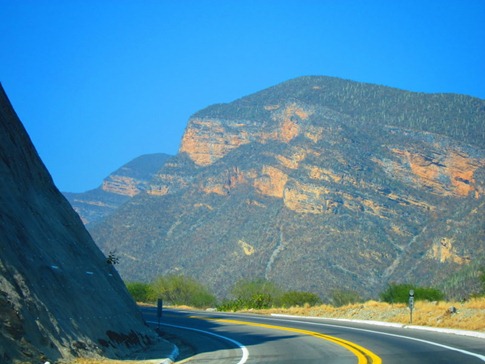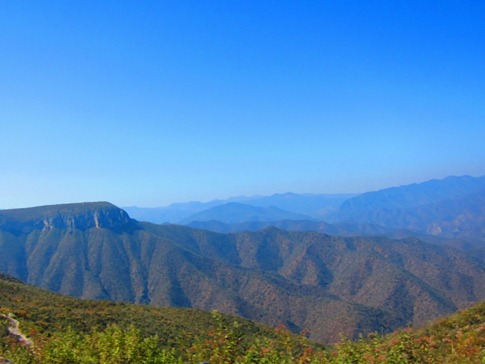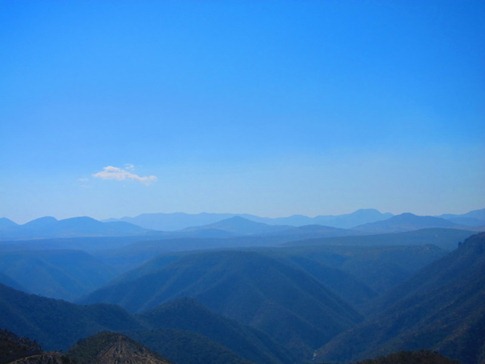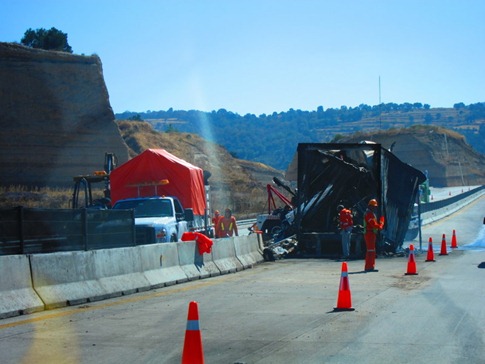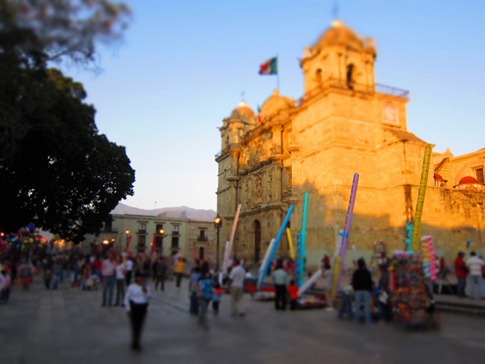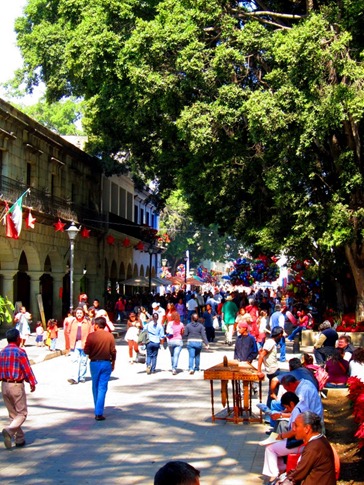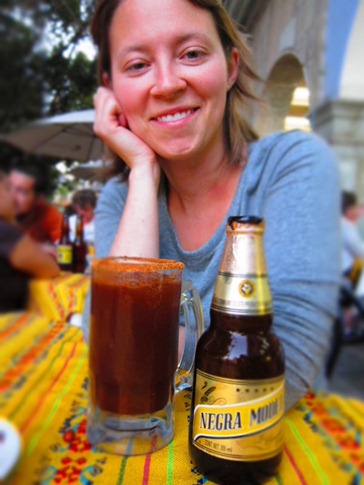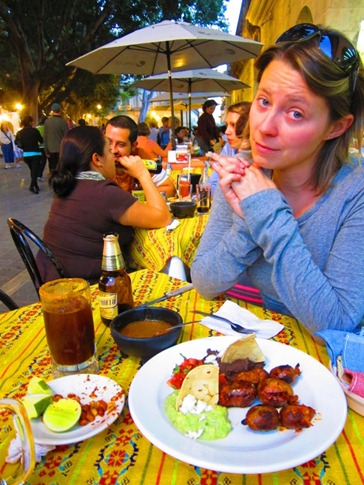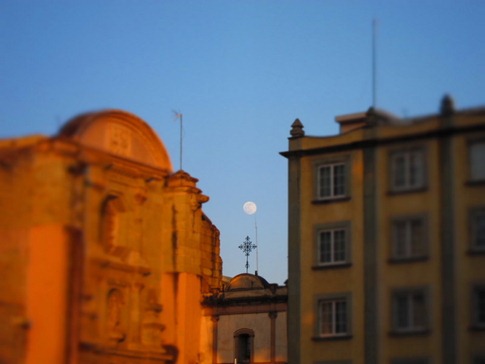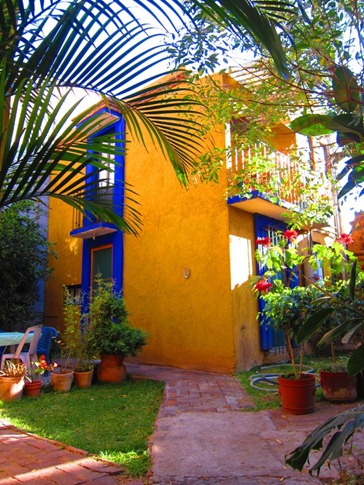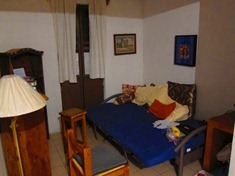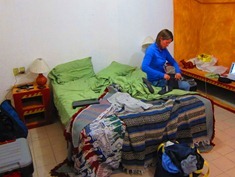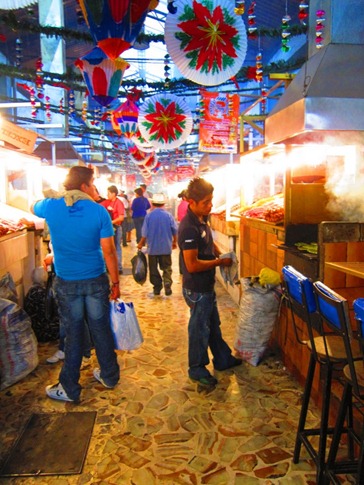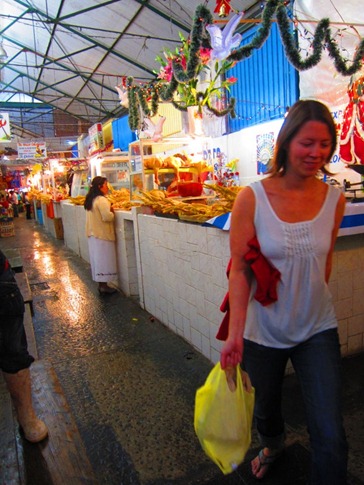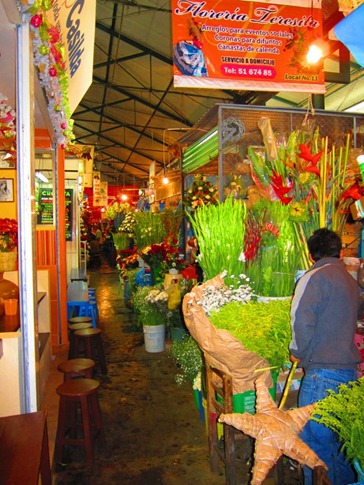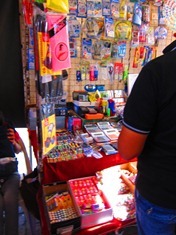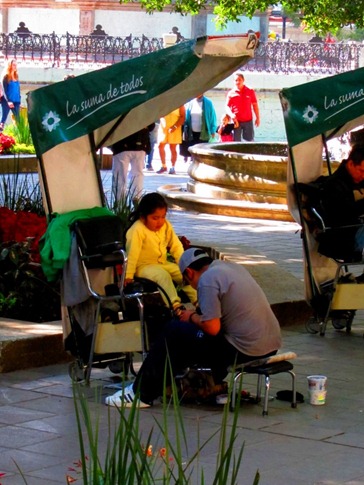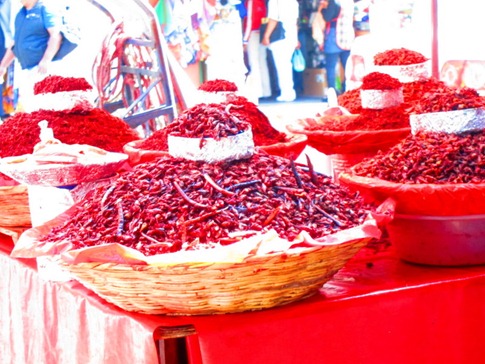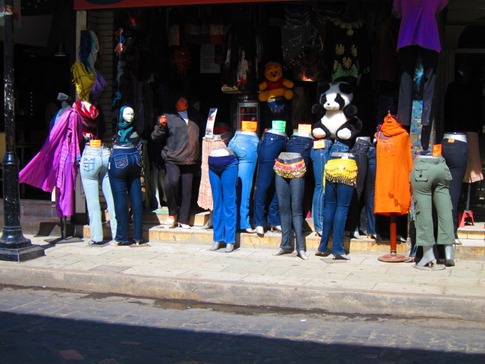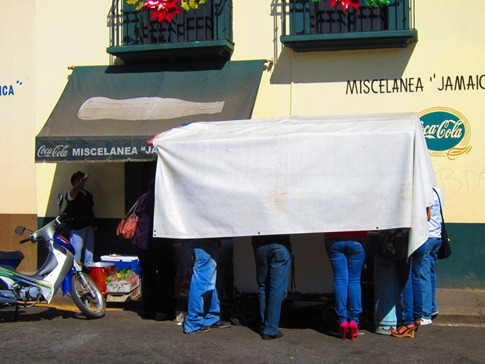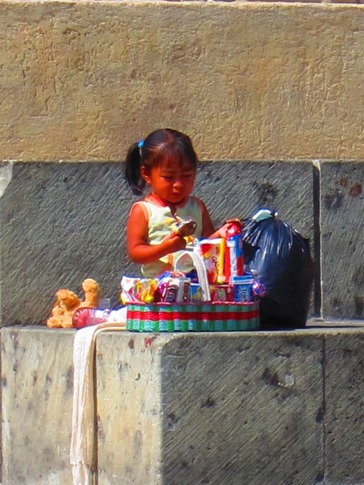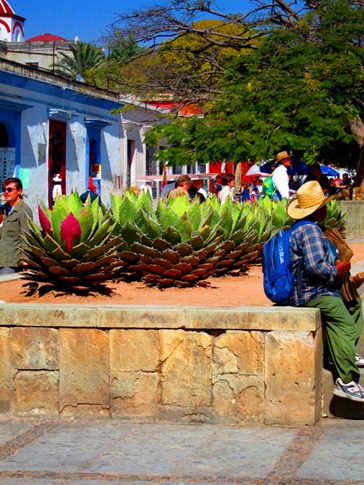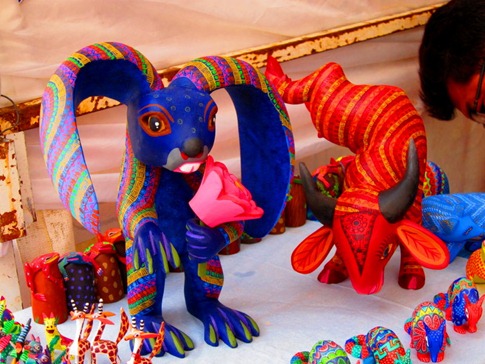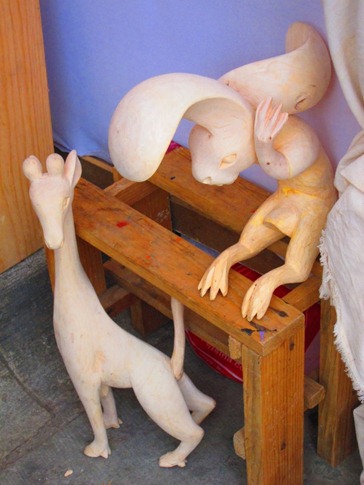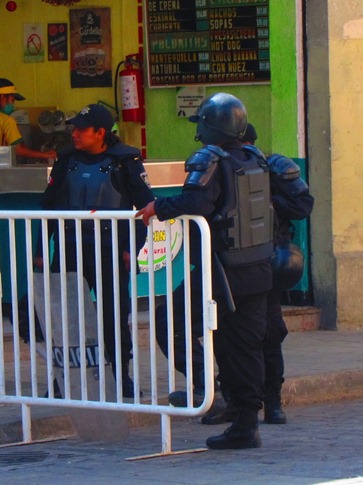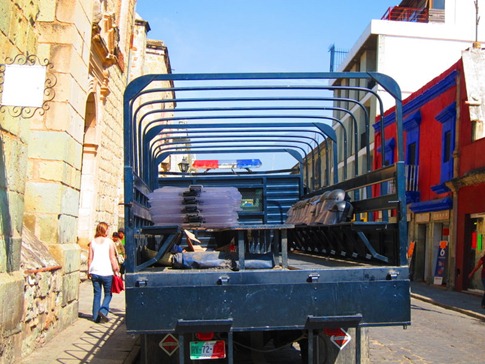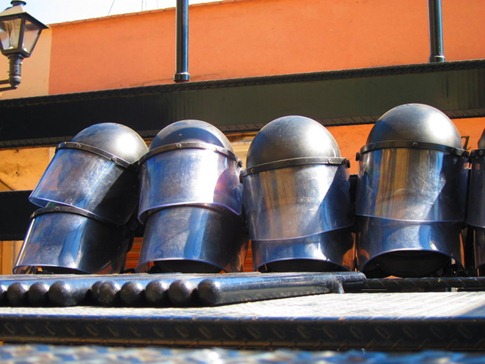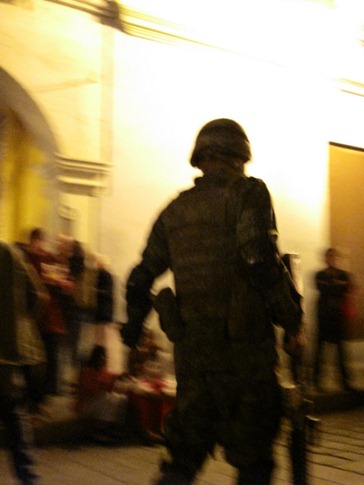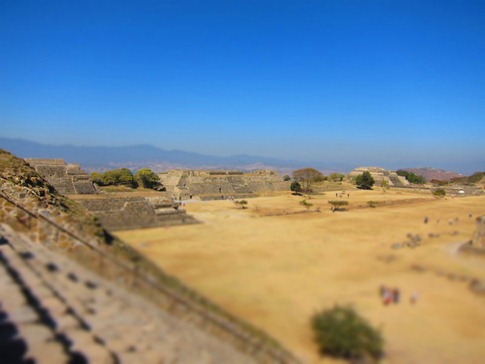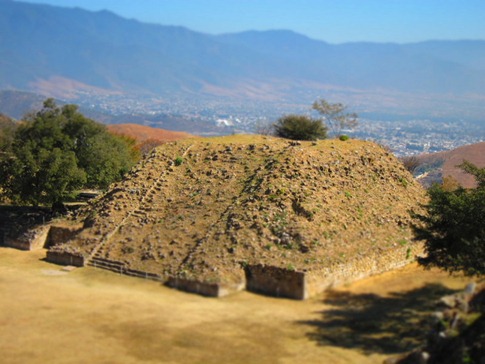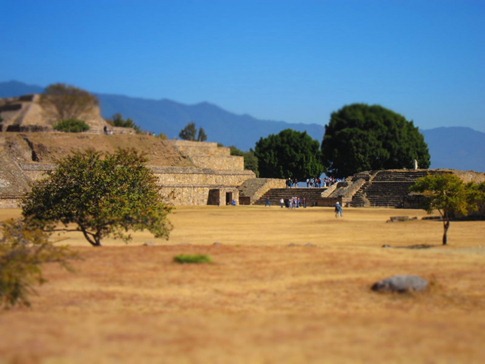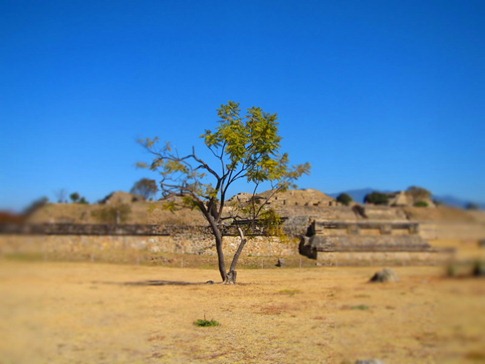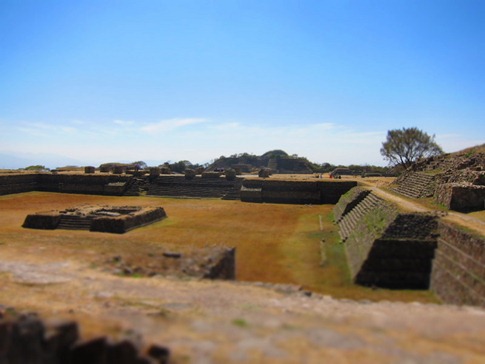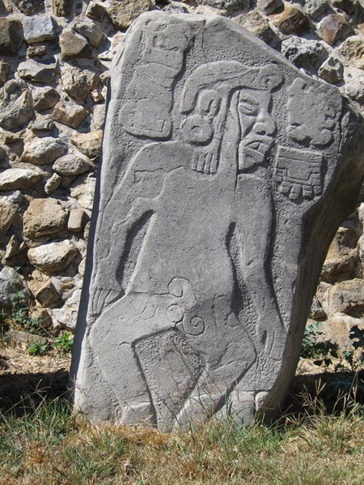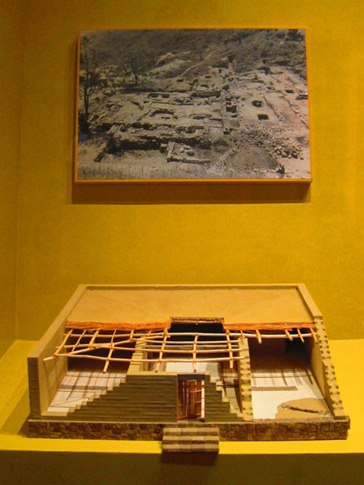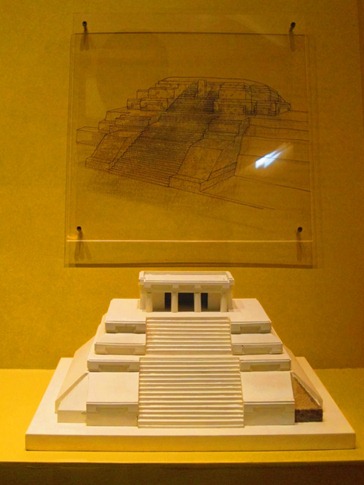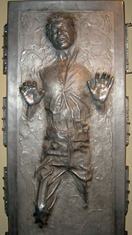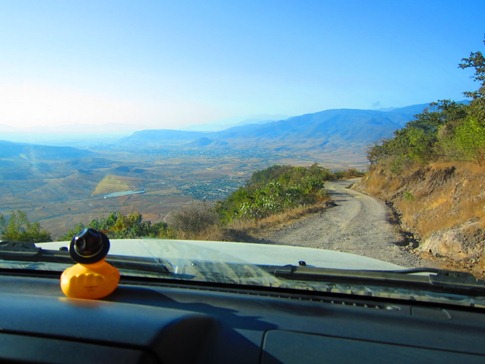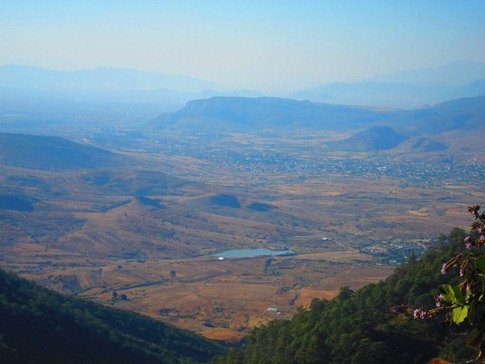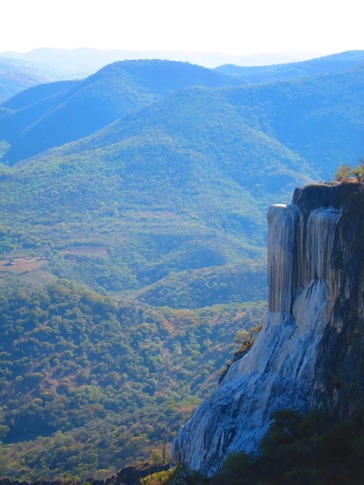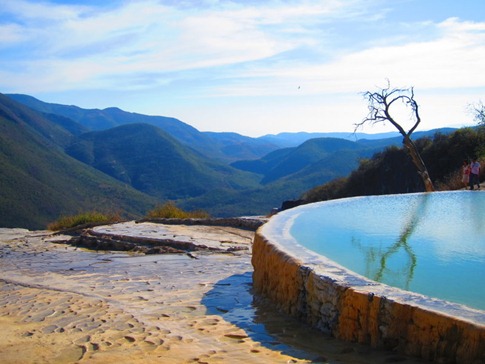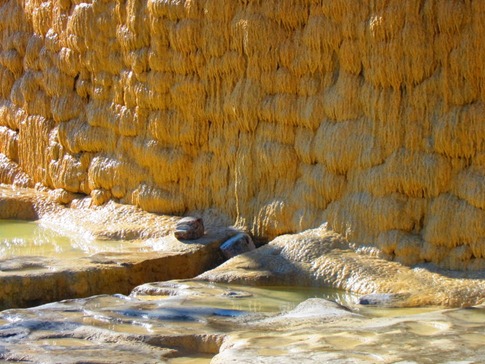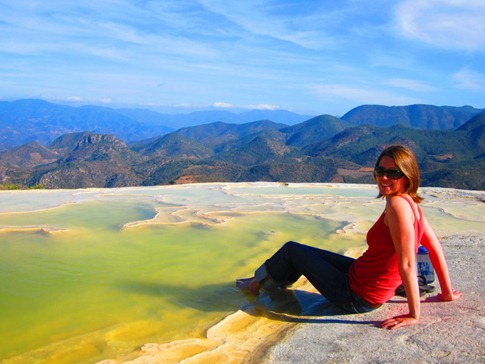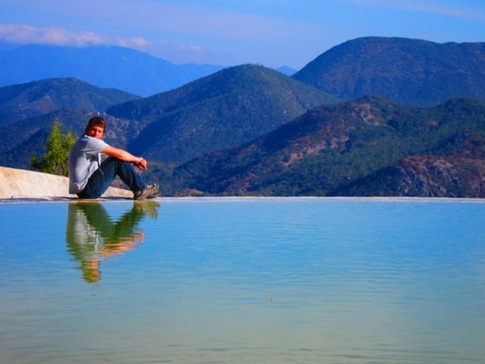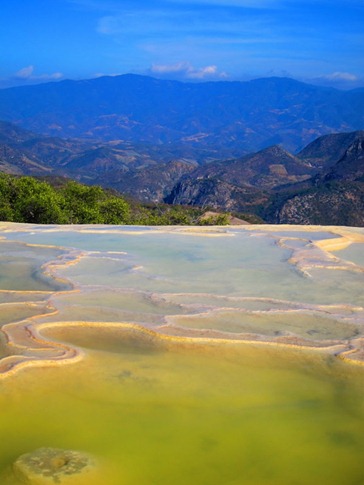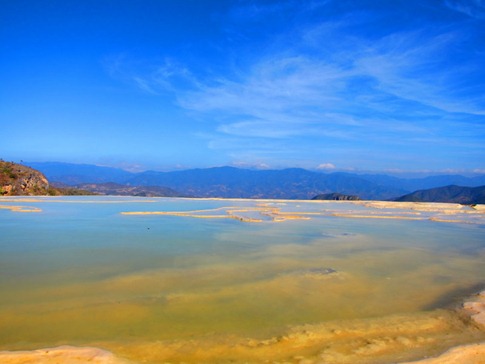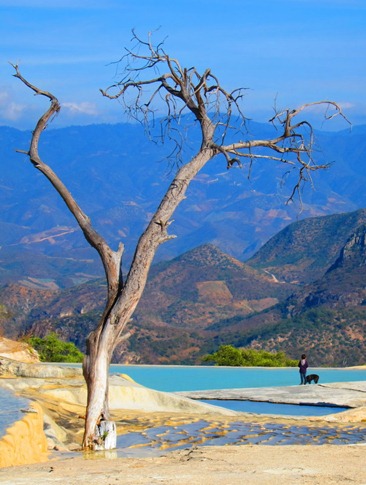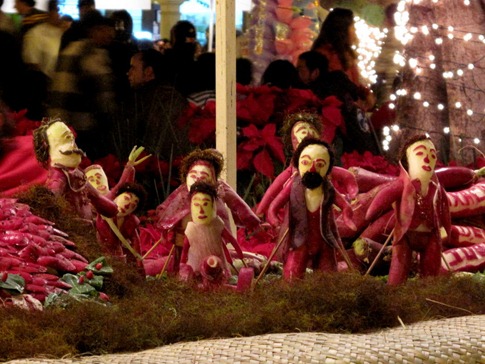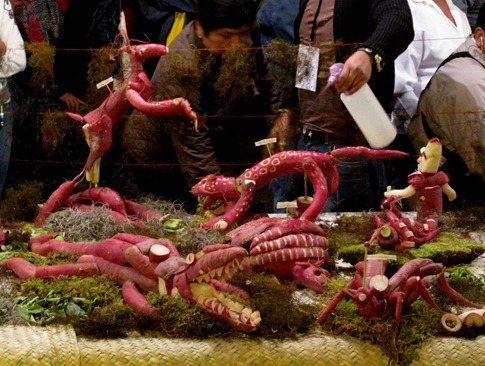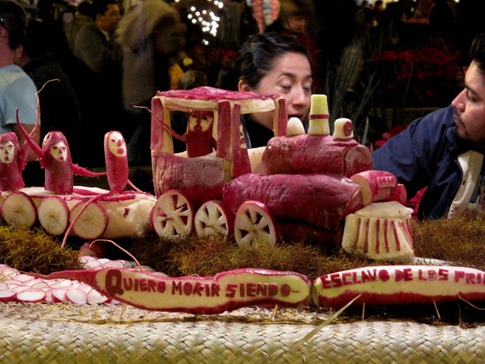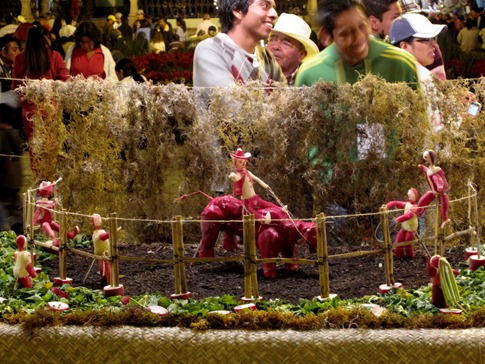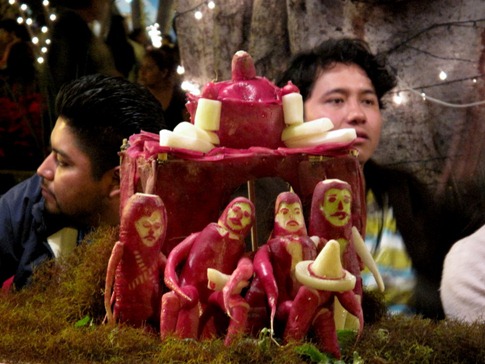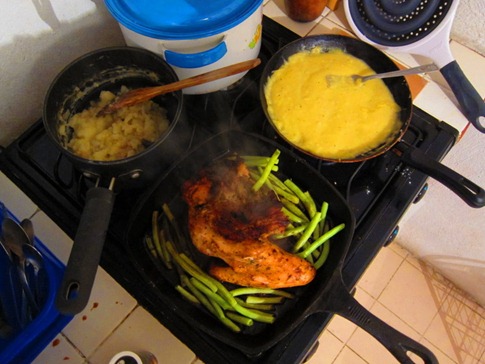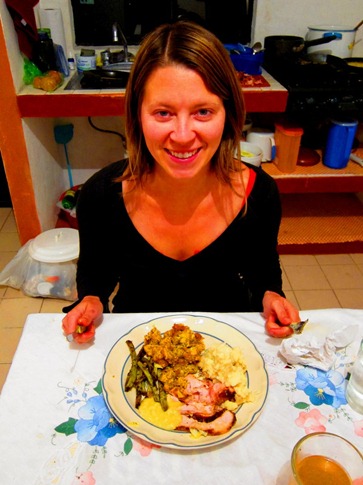Seven emails sent out and seven polite no responses. A thread on TripAdvisor had suggested looking in the classified section of the Oaxaca Times, the newsletter of a Spanish school in town, for short-term rentals, but it was starting to seem like finding one last minute the week before Christmas wasn’t very likely. Then again, it was Sunday, and despite the fact that we’d received responses back within hours, we rationalized that we might have better luck once we got there.
South of Mexico City, large volcanic cones fade into focus through the haze. Though some are still active, they emit only small puffs of white smoke barely deserving of a “Participant” ribbon in the science fair.
The toll road between Tehuacan and Oaxaca passes through the Biosphera de Tehuacan-Ciutcatlan, a unique desert landscape on the dry slope of the Sierra Madre, as it winds steeply through dramatic buttes carpeted with thin, upright cactus. Beyond, huge expanses of canyons disappear into the horizon.
Again, the morning often provides reminders of high speeds, poor visibility and surprises one can encounter on Mexican roads at night.
Three hours later, we felt our way into Oaxaca, finding ourselves in a congested, dirty and frankly, pretty sketchy looking part of town. Both thinking it but neither saying it out loud, it did not seem like a place we’d want to spend a few days, much less Christmas. But following a main road across town, boutique hotels started to appear, with flower-covered balconies above grand wooden doors and their shutters open to reveal spacious interior courtyards. A wide pedestrian promenade paralleled us a block over and emptied into a bustling plaza in front of a majestic, stone church and language schools and internet cafes became more common. Soon, we couldn’t wait to start looking for a place to stay the week.
It always takes a few rotations of the map to figure out where we are based on the landmarks we’re seeing as we crawl down narrow streets, scanning for names and the arrows that appear below them to indicate if they’re one way, all the while, making a snap decision as to whether right of way in the intersection is “uno a uno,” based on a carefully hidden stoplight or, as is commonly the case, determined by whichever street has a better flow of traffic. While Mexican drivers are “proactive,” taking advantage of situations and never truly coming to a stop that would convince you they are yielding, there is a complete absence of road rage or perceivable frustration other than the occasional horn when traffic backs up inexplicably. Traffic cops with motorcycles marked “Transito” will occasionally monitor an intersection, blowing their whistles in complex but unintelligible bursts to varying degrees of compliance from the drivers. It seems the relative lawlessness of the road has resulted in an every-man-for-himself approach that is often more predictable than the alternative. I say sometimes that driving in Mexico is like walking downtown San Francisco; If you want to be constantly looking for an opening in the crowd or momentarily speeding up to get past someone without really affecting them, you do it.
We got settled into a nice bed and breakfast a few blocks north of the zocalo. The only disadvantage was that parking was tandem meaning that you had to leave your keys in case other cars needed to be moved. My fist instinct of course was no way, but if you think about it, any hotel you stay at, they’ve got the keys to your room and could easily rob you blind if they wanted. They’re not going to steal our car and as long as we keep the keys to the various locking compartments inside, there’s not really anything to be taken. Sometimes you get so used to being on guard that you forget to be reasonable.
In the room, we got an email back from a last minute apartment inquiry we’d made before leaving Tehuacan. Teresa had an apartment available through Christmas and could show it to us in the morning. We walked by the address and it looked great! Well, until we realized it was the one next door with a few graffiti tags and an imposing looking electric fence on top of a high wall. We walked back towards the zocalo, willing to see the place the next day but not hopeful.
Like everywhere we’ve been, the mood in the zocalo was festive with families walking along the cobbled paths lined with noche buenas (poinsettias) that diagonal out from the central gazebo. In front of the church, vendors sold colorful balloons and long inflatable tubes that kids would send flying through the air like bloated javelins until they’d harmlessly hit someone in the back of the head. We took up a outdoor table on the periphery and ordered a michelada (this time picante). Though still skeptical after “the sausage incident,” once a little tipsy Ann was willing to try some of the local Oaxaqueno sausage I ordered.
As the sun set, a rotating cast of musicians set up shop in front of the tables and played a few songs before coming over to collect a few pesos. An old man with a solo saxophone sounded like he was playing horn parts from a mariachi band that had disbanded years before but had neglected to tell him. A duo with guitar and a 10 string instrument with a tiny body both had multi-tubed flutes made of what looked to be PVC strapped below their mouths and could simultaneous play complicated rhythms and harmonies. For some reason, at any given time in the zocalo, someone was playing either “Besame Mucho” or “In the Jungle (the Lion Sleeps Tonight).”
The next morning, we met Teresa (“Tere”) at the apartment and were relieved once inside the gates to find it as advertised, “a green oasis in Oaxaca.” Ten or so bright yellow apartments, some doubles and some studios, were arranged in a garden-like setting behind a house where Tere lived. She explained that everything had been booked solid until she got a cancelation that day and quoted the cost at 2,800 pesos for the week. I fumbled through the Spanish to say that I thought I recalled it saying 2,100 on the web site. We started to check online, but when I saw a sign on her office wall clearly showing the price at 2,800, I was sure I’d made a mistake. When we returned from the bed and breakfast with the truck and the cash, she said she’d checked her web site and it in fact did say 2,100, so she would honor the price, commenting that her daughter who updates the site must have forgotten to change it. We were all set with a 1 bedroom 2 bath apartment with a kitchen, cable TV, wireless internet and secure parking for about $180 for the week.
Admittedly, once we unpacked a little, it was nice not to really do much of anything and take a little “vacation from the trip.” We Skyped with friends and family; got laundry done, again returned to us perfectly folded and wrapped in plastic making it very unlikely that we’ll ever be able to go back to doing it ourselves; went to the local mercado where we stocked up on vegetables, fresh ground coffee and sinfully rich Oaxaqueno chocolate; and generally ventured in to the centro every few days. A large, Walmart-like, Chedraui store a few blocks away provided the rest of the staples we needed to try some salsa recipes and make delicious Pozole soup with huge kernels of corn called “hominy” while playing house for a week.
Oaxaca was a nice mix of a big city but with the feel of a small town that spread out for blocks and blocks in all directions. Venturing away from the zocalo, we’d walk through stalls of vendors, sometimes wondering if they all bought from a Build-a-Stall company offering kits with predetermined product selections. “So what’ll be? You want the nail clippers, earbuds and remote controls variety pack or would you prefer to sell sunglasses, batteries and disposable razors? Those are the options.” A lot of places we’ve been, people tend to sell all the same things right next to each other. After a toll booth, there will be 10 trucks parked along side of the road, all selling oranges or dried shrimp and all with the same prices. Along one section of highway, we must have passed 15 displays of the same toy trucks by the side of the road. As we’d slow for each tope in a small town, 6 people, each holding the same bag of 3 halved corn cobs and a carrot, would approach the window trying to make a sale. Even more bizarre, when we’d come to the next tope 20 ft later, 6 more would approach us, I guess figuring we really did want to buy corn cobs and a carrot in a bag but hadn’t liked the offerings at the last tope.
If you come to Mexico, bring shineable shoes. The squares are full of these shoe shine chairs attracting clients of all ages.
Savory fried grasshoppers were another favorite in Oaxaca although we’d been told by a friend that when you bite into them, the insides gush out like one of those pieces of gum with liquid in the center.
Anyone who’s walked along Mission St. in San Francisco has seen the displays in the clothing stores with torso-less legs and butts bending over seductively to show off the form of the jeans they’ve been shoehorned into. I liked this display outside a maternity clothing store that had the same displays but with more “generous” proportions in the back and elastic in the front.
And in fairness, some people really only need to look good from the waist down.
An unfortunate trend we’ve been seeing in the southern part of Mexico is the involvement of children in selling gum, shawls, tiny figurines, etc. They’ll walk up to your table with hollow eyes and dirty faces, pushing whatever they have towards you. It’s tough to respond with a “No gracias” when the price goes from 40 pesos to 15 in about 10 seconds, and you know that the money would make a difference to them, but you also know their parents have pressed them into this service and it shouldn’t be encouraged. We made another note to look into children’s charities in Oaxaca that may know more about the issue and be working on solutions.
The northern part of town has a beautiful cathedral and vibrant craft market.
We couldn’t resist buying ourselves (and my mom) a present from this guy who hand carves these fanciful one-of-a-kind creatures which his wife then paints in bright colors and intricate patterns.
There’s a distinct security presence in Oaxaca, with the pedestrian areas cordoned off by barricades lined with 5 or 6 officers in what looks like riot gear. Some of them are wearing sleek bulletproof vests while others have rotomolded plastic that makes them look like they took some black spray paint to a Teenage Mutant Ninja Turtle Halloween costume. Still the officers, male and female we found it interesting, were joking with each other and smiling at the people walking by, leaving us feeling quite safe and comfortable.
This guy was among a smattering of Mexican Army soldiers walking around the crowded zocalo in the evening. Ann commented “I’ve never been this close to a gun that big before.” The only thing he was going to be able to do with that thing should anything flare up is saw the entire crowd in half.
After a few days of blissful laziness, we decided to get out and see the sights outside of Oaxaca. Our first stop was the ruin site of Mont Alban. Now this is a location where we could see building an ancient city; Perched on top of a hill with a 360 degree view which today includes Oaxaca and the surrounding valleys.
The open, grassy areas are surrounded by raised platforms for the homes of city and religious leaders and something like 9 ball courts for the ceremonial game of “pelota.” The models below show how some of these structures might have looked.
I never did understood why they had a statue of Paul Schaffer that looked like he’d been frozen in carbonite by Jabba the Hut.
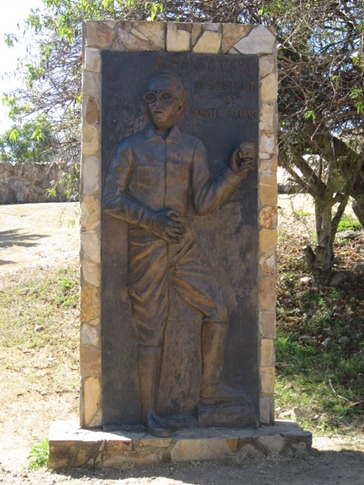
While we were out, we figured we’d hit the other attraction we’d heard about: Hierve el Agua or “the water boils.” 45 minutes out the other side of town and after a brief stop in the huge but forgettable artisanal market in Mitla, we started up the 14km dirt road that bumps and winds its way steeply up a mountain and down the other side to a surprisingly developed area popular with tourists and Oaxaquenos. While we were glad to have high clearance and at least the option of four wheel drive, there were plenty of sedans, large tourist vans and the local “buses,” pickups with benches in the bed and a shade cover, on the road. Do not even consider taking one of these on the 45 minute each way trip.
The water does not actually boil but rather bubbles from a spring, enriched with minerals from the rock formation. As it flows towards the cliff, it leaves a trail of these minerals that over the years have formed petrified waterfalls and pools that are quite stunning.
As I’m sure you know, December 23rd is the Night of the Radishes, “Noche de Rabanos.” For over a hundred years, artists have displayed intricately carved radishes in the zocalo, competing for prizes while the tourists and locals madly snap pictures. Apparently, the practice started when vendors selling traditional plates of vegetables for Christmas dinner started embellishing them with carvings to differentiate themselves. Soon, local housewives were competing among themselves for who had the most ornate spread.
Christmas morning was a flurry of Skypes with family and friends including Ann getting to watch her twelve-year-old twin sisters open their presents in Weston, Massachusetts. In the afternoon, we had a nice potluck in the shared garden of our apartment complex with the assorted residents ranging from a grad student there for a year to cruisers who left their boat in Guatemala to explore Mexico for a couple months to one couple who had been there for 8 years; they had since added an extra room and a covered dining patio at their own expense.
We excused ourselves as it was getting dark to start preparing our first solo Christmas dinner together. I think we did pretty well: cooking a turkey breast and wing in the griddle pan along with some green beans and making homemade stuffing, mashed potatoes and gravy on the tiny four burner stove with no oven.
Oaxaca was a great place to spend Christmas, and we’d highly recommend these apartments (info on our Where Have We Been? page) to anyone coming wanting to stay for more than a couple days. After a relaxing, mostly stationary week, we were ready to get back in the truck and head for the coast and New Years on the Pacific Coast at Zipolite.


